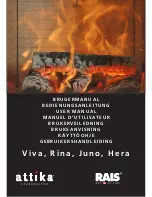
Wood burning stove/cooker
– TERMOROSA DSA
Installation, user and maintenance instructions – EN – Rev.02
29
possible that the entry of fresh air is no longer guaranteed and this compromises the draught of the appliance, your
wellbeing and safety. Therefore it is necessary to guarantee an additional fresh air feed through an external air inlet
placed close to the appliance or through the laying of a duct for the combustion air which connects to the outside or in
a nearby ventilated room, with the exception of the boiler room or garage (FORBIDDEN).
The connection duct must be smooth with a minimum diameter of 120 mm, must have a maximum length of 4 m and
present no more than three bends. If this is directly connected with the outside, it is must have an appropriate
windbreak.
The combustion air inlet in the area of installation must not be obstructed during the operation of the wood burning
stove/cooker. It is essential that in the areas where the wood burning stoves/cookers operate with a natural draught of
the chimney, as much air as required for combustion, which is up to 25 m3/hr, is admitted. The natural recirculation of
the air must be guaranteed by a number of fixed openings to the outside, their size is decided by relevant regulations
on the matter. Ask for information from your trusted chimney sweep. The openings must be protected with grills and
never be obstructed. An extraction hood (extractor) installed in the same room or one nearby causes a depression in
the area. This causes leakage of combustible gases (dense smoke, smell); it is therefore necessary to ensure a
greater flow of fresh air.
The depression of an extraction hood can, in the worst of cases, transform the flue of the wood burning
stove/cooker into an external air inlet re-sucking the smoke into the environment with detrimental
consequences for people.
8. ALLOWED/FORBIDDEN FUELS.
The fuels allowed are wood logs. Only dry wood logs must be used (containing a max water content of 20%). The
logs should have a length of 30 cm and a max. circumference of 15-18 cm.
The wood used as fuel must have a humidity content lower than 20% which is obtained with a drying time of at least
one year (soft wood) or of two years (hard wood) placing it in a dry ventilated area (for example under a roof). Damp
wood makes lighting more difficult, as a greater amount of energy is needed to evaporate the water present. The
humidity content also has the disadvantage, with the lowering of the temperature, of making the water condense first
in the furnace and then in the chimney. Fresh wood contains approx. 60% of H20 therefore it is not suited to being
burned.
Among other things which cannot be burned: remains of coal, cuttings, wastes of bark and panels, damp
wood or wood treated with paints, plastic materials: in this case the guarantee on the appliance is null and
void
WOOD FUEL IN COMMON USE
* RESINOUS WOODS NOT SUITABLE FOR THE WOOD BURNING STOVE/COOKER
Paper and cardboard must be used only for lighting. The combustion of wastes is forbidden and would damage
the wood burning stove/cooker and the flue, creating a health hazard and the disturbing smell would give rise to
complaints by the neighbourhood.
Wood is not a long term fuel and therefore it is not possible to have continuous heat of the wood burning stove/cooker
during the night.
WARNING: The continuous and prolonged used of wood particularly rich in aromatic oils (e.g. Eucalyptus,
Myrtle, etc.) causes sudden deterioration (flaking) of the components in cast iron present in the
product
Species
Kg/mc
KWh/kg Humidity 20%
Beech
750
4.0
Oak
900
4.2
Elm
640
4.1
Poplar
470
4.1
Larch*
660
4.4
Spruce*
450
4.5
Scots pine*
550
4.4
















































